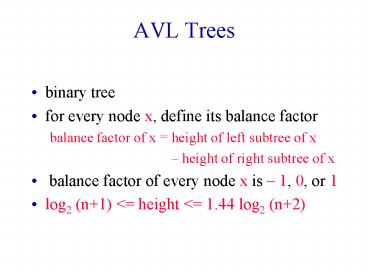AVL Trees - PowerPoint PPT Presentation
Title:
AVL Trees
Description:
AVL Trees binary tree for every node x, define its balance factor balance factor of x = height of left subtree of x height of right subtree of x – PowerPoint PPT presentation
Number of Views:120
Avg rating:3.0/5.0
Title: AVL Trees
1
AVL Trees
- binary tree
- for every node x, define its balance factor
- balance factor of x height of left subtree of x
- height of
right subtree of x - balance factor of every node x is 1, 0, or 1
- log2 (n1) lt height lt 1.44 log2 (n2)
2
Example AVL Tree
3
put(9)
-1
10
0
1
1
7
40
-1
0
1
-1
0
45
8
3
30
0
-1
0
0
0
0
60
35
9
1
20
5
0
25
4
put(29)
-1
10
1
1
7
40
-1
0
1
0
45
8
3
30
0
0
-1
0
0
-2
60
35
1
20
5
0
-1
RR imbalance gt new node is in right subtree of
right subtree of white node (node with bf 2)
25
0
29
5
put(29)
-1
10
1
1
7
40
-1
0
1
0
45
8
3
30
0
0
0
0
0
60
35
1
25
5
0
0
20
29
RR rotation.
6
Insert/Put
- Following insert/put, retrace path towards root
and adjust balance factors as needed. - Stop when you reach a node whose balance factor
becomes 0, 2, or 2, or when you reach the root. - The new tree is not an AVL tree only if you reach
a node whose balance factor is either 2 or 2. - In this case, we say the tree has become
unbalanced.
7
A-Node
- Let A be the nearest ancestor of the newly
inserted node whose balance factor becomes 2 or
2 following the insert. - Balance factor of nodes between new node and A is
0 before insertion.
8
Imbalance Types
- RR newly inserted node is in the right subtree
of the right subtree of A. - LL left subtree of left subtree of A.
- RL left subtree of right subtree of A.
- LR right subtree of left subtree of A.
9
LL Rotation
0
2
1
0
After rotation.
- Subtree height is unchanged.
- No further adjustments to be done.
10
LR Rotation (case 1)
2
0
-1
0
0
0
After rotation.
- Subtree height is unchanged.
- No further adjustments to be done.
11
LR Rotation (case 2)
2
0
-1
0
-1
1
- Subtree height is unchanged.
- No further adjustments to be done.
12
LR Rotation (case 3)
- Subtree height is unchanged.
- No further adjustments to be done.
13
Single Double Rotations
- Single
- LL and RR
- Double
- LR and RL
- LR is RR followed by LL
- RL is LL followed by RR
14
LR Is RR LL
15
Remove An Element
Remove 8.
16
Remove An Element
q
- Let q be parent of deleted node.
- Retrace path from q towards root.
17
New Balance Factor Of q
- Deletion from left subtree of q gt bf--.
- Deletion from right subtree of q gt bf.
- New balance factor 1 or 1 gt no change in
height of subtree rooted at q. - New balance factor 0 gt height of subtree
rooted at q has decreased by 1. - New balance factor 2 or 2 gt tree is
unbalanced at q.
18
Imbalance Classification
- Let A be the nearest ancestor of the deleted
node whose balance factor has become 2 or 2
following a deletion. - Deletion from left subtree of A gt type L.
- Deletion from right subtree of A gt type R.
- Type R gt new bf(A) 2.
- So, old bf(A) 1.
- So, A has a left child B.
- bf(B) 0 gt R0.
- bf(B) 1 gt R1.
- bf(B) 1 gt R-1.
19
R0 Rotation
- Subtree height is unchanged.
- No further adjustments to be done.
- Similar to LL rotation.
20
R1 Rotation
- Subtree height is reduced by 1.
- Must continue on path to root.
- Similar to LL and R0 rotations.
21
R-1 Rotation
- New balance factor of A and B depends on b.
- Subtree height is reduced by 1.
- Must continue on path to root.
- Similar to LR.
22
Number Of Rebalancing Rotations
- At most 1 for an insert.
- O(log n) for a delete.
23
Rotation Frequency
- Insert random numbers.
- No rotation 53.4 (approx).
- LL/RR 23.3 (approx).
- LR/RL 23.2 (approx).































